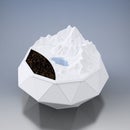Introduction: How to Create a Typographic Portrait in Illustrator
Hello people
I am sure you guys must have seen the amazing typographic portraits artist have made all over the world featuring eminent personalities and famous stars. If you have ever wondered how to go on about creating one for yourself, this instructable is for you.
You can create a typographic portrait for your loved ones with ease and surprise them. So lets start with the tutorial.
What you would need :
- Base image which you would like to convert to a typographic portrait.
- A vector software like Adobe Illustrator. Some others are coral draw, inkscape, gimp etc
- Patience
- Little creativity (optional)
I will be using Adobe illustrator to demonstrate this tutorial. However almost all vector softwares have the same basic tools and this tutorial can be replicated easily with other vector softwares.
Step 1: Choosing a Base Image
The first task you have to do is choose an image to base your typographic portrait on. Be careful to choose an image which has good contrast between subject and background.
The image should not be under exposed or over exposed. This will make your job tougher. The image should be black and white or coloured converted to one.
For the tutorial , I will chose a coloured image and then converted it to a black and white image. Converting the image to black and white helps in understanding the shades of the subject in a better way. This in turn will help you to choose the appropriate text shade giving a more life like depth to the typographic portrait.
I chose my own image and converted to black and white using Illustrator. You can use any other software to do the same.
- Open a new file in Illustrator
- Place the image in the newly opened file.
- From the 'Image trace' option click 'Shades of grey'
Take a look at the pictures for any clarification. The resulting image is also attached. This gives us the base picture on which our typographic portrait will be created.
Step 2: Defining Key Text Areas of the Image
Now this is the most important and tricky part. This step can make or break your typographic portrait. The idea here is to break down the image into as small text sections as possible. The text sections can be divided on the basis of the following :
- Different shade required
- Different text slope required
- Different text size required
The more number of sections you divide your picture into, the more crisp and accurate your typo portrait will be. However this also means a lot of fine detailed work and requires a lot of patience. For the sake of this tutorial I will break down the image into a moderate number of text areas.
Have a look at the attached image to understand how I have broken down the image into key areas based on the above three parameters.
Also you will have to define any objects like spectacle rims etc with a line of text.
Step 3: Creating Slope Lines for the Text
The second most important step is to create slope lines across the subject. This is more like depicting the contour through the lines. These lines will be used to write the text along the line curve. The curved text will give fullness to the typo portrait so make sure you take plenty of time and don't rush this step.
Open Pen Tool in illustrator and start creating lines based on the subject.
You don't have be very accurate in creating a perfect smooth curve using the pen tool. After you have created the rough lines you can use the line smooth tool to improve the curves.
It is absolutely not necessary that you have to create the contour line exactly like I have done. You can experiment with your own style. This is where your creativity kicks in. You are the creator of your own masterpiece and experimenting with different styles will only improve your skill and creativity.
Take a look at how I have defined the slope/contour lines for my subject.
Step 4: Start Writing the Text
This is where the fun part begins. After you have completed drawing the slopes, use the type on a path tool in illustrator to write text on the slope lines or contours. Experiment with different font sizes, different font colours etc. Remember there is no right way to do this, there is just your way.
Use words that describe your subject or better write a letter to them through this typographic portrait. After you have finished writing the text, use the key text areas that you defined in step 2, to decide the colour of the font.
Remember to experiment with different fonts, size and colour. Stop only when you are satisfied with the look.
This was my first attempt at creating a typographic portrait and took me well over a month. So remember there is no short-cut to create your masterpiece.
Step 5: Conclusion
I hope you got a good understanding of the process to create a typographic portrait. I have attached various crops of my portrait for you guys to have a look at.
These show the minute details that went into creating this portrait and possibly helps you get an idea on how to create yours.
If you have any comments doubts, shot them at me and I will be happy to respond.
Cheers
Ankur Kaul
www.allthatido.com






